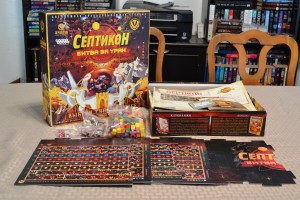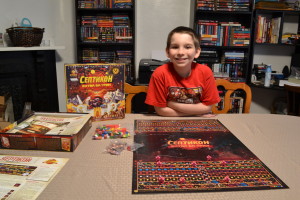Before you ask, no…this isn’t a game isn’t about some lost, wayward robotic faction that Megatron had hiding under his sleeve all this time. Rather, “Septikon” is a board game for two players that features tower-defense mechanics in a retro-futuristic atmosphere. For those of you who frequent my video game reviews, you’ll know that I love me some tower defense. Tower defense games have a way of keeping you on your toes, not to mention the fact that they can be hopelessly addicting. Needless to say, I was intrigued by what this game had to offer. Before we take a quick look at what “Septikon” is all about, I’d like to thank Ivan Karmanov from Hobby World for reaching out and providing me with a press copy. Since the game is still in the process of being funded through Kickstarter, you may or may not see a difference between the final product and the content featured below.
“Septikon” takes place in an asteroid belt that happens to be rich in the rare resource, uranium. Both you and your opponent have powerful mining stations within this asteroid belt and rather than settle things peacefully, you’ve opted to simply let the better man (or woman) win. The object, as you may have guessed, is to throw waves of attackers at your enemy while fending off the very same waves he or she will be throwing at you. In a sense, “Septikon” is not only a tower defense game, but also incorporates tower offense mechanics. For those of you familiar with the board game “Castle Panic”, it’s important to stress that “Septikon” is purely a 1 vs 1 experience…oh but what an experience it is.
At first glance, the board looks a bit intimidating. Each player has eight different rows lining their side of the board, each with more icons and symbols than you can shake a stick at. These icons (called modules) represent the resources, tools, and weapons that players will be using to win the game. It’s easier when you break these modules up into their five respective zones: two warehouse zones (which house a total of eight different resource types), one production zone (which mainly serves to convert one resource type into another), one battle zone (which allows you to create offensive & defensive weaponry), and one armory zone (which allows you to equip your clones with powerful weaponry). There is also one very important row that sits above all of these zones that allows players to aim and fire their weapons with their clones, but more on that in a bit.
In between both players is a neutral zone of sorts that allows them to dispatch offensive weaponry from one side of the board to the other. It’s essentially a battlefield that separates the two home bases. Not to worry, it’s large enough to where players have time to react appropriately to threats as they arise. However, with the right modules and combinations, a player can break through their opponent’s line of defense and come out on top. It’s a LOT to take in at first and remembering which module does what can be a challenge, though I appreciated the fact that most of them contained easy to read symbols that outlined how they behaved.
The game is played over a series of turns. On a particular player’s turn, they’ll roll the die and move one of their clones (workers) from one icon to another. Once a clone lands on the new icon, they activate that module and depending on the circumstances, the player follows through with that action. Clones can also navigate the ninth row, which borders the battlefield. Once in this row, clones act as “gunners” that allow players to fire the weapons they’ve created. Players will be able to move whichever clone they’d like after rolling the die, so there is no shortage of options when it comes time to make a decision. It’s also worth mentioning that in addition to moving a clone, the objects on the battlefield move in accordance to the die roll…think of it as time advancing for that player. It’ll take a game or two to full grasp all of the different options you’ll have, but in my opinion it’s well worth it.
Vinnie (12), like myself, was overwhelmed at first by all of the different options available to him. From a parental standpoint, I found that I had to take on the mentor role for our first couple of games in order to steer him in the right direction. Once he began to see how the modules could be used in conjunction in order to unleash powerful attacks, I had to take off the proverbial training gloves in order to keep up. This wasn’t the type of game he was used to playing (“Castle Panic” being the only other tower defense board game that we currently own), but I’m glad to report that he enjoyed the experience and commented repeatedly on how much he liked all of the different weapons that were available to him.
It wasn’t until after our first few games that I really began to appreciate how in-depth “Septikon” really was. Vinnie’s comment sums up my thoughts exactly in that there is a plethora of different choices to make (and weapons to use). This ups the replayability tenfold and with the assistance of the dice mechanic, no two games will ever be the same. To that end, “Septikon” truly is a remarkable achievement and worthy of your time. It’s the type of tower defense / offense game that I’ve always wanted to play on my dining room table, and I consider the time I’ve spent learning its ins and outs to be well worth it. Simple yet complex, “Septikon” is strategic, in-depth, and a heck of a lot of fun to play.
—
“Septikon” was originally published and released in Russia circa 2012. The Kickstarter campaign I mentioned above is primarily designed to assist the game in launching internationally. You can help to support this goal and learn more about the game via the links below:
http://www.kickstarter.com/projects/1194220798/septikon-uranium-wars
http://boardgamegeek.com/boardgame/131457/septikon
http://international.hobbyworld.ru/
https://www.facebook.com/septikongame
https://twitter.com/Septikon_Game


